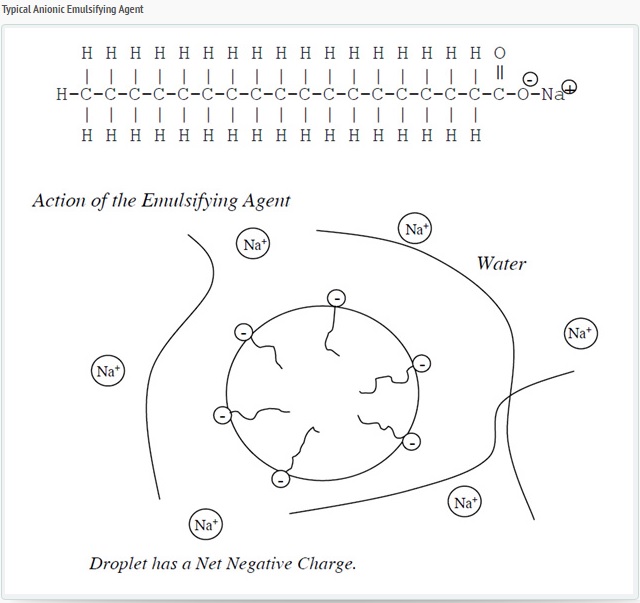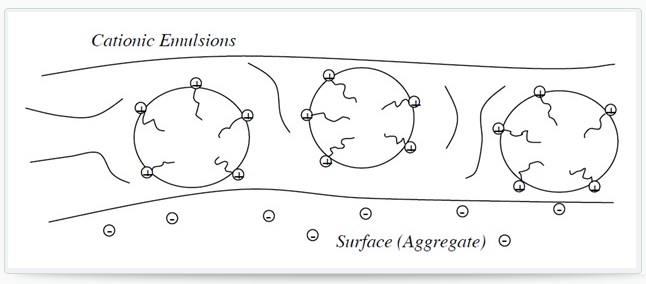Cationic Bitumen Emulsion
General Description of Cationic Bitumen Emulsion
The term cationic is derived from the migration of particles of bitumen under an electric field also. The droplets migrate toward the cathode (negative electrode), and hence the emulsion is called cationic. The cationic emulsifying agent functions similarly to the anionic; the negative portion of the head floats around in the water leaving a positively charged head. This imparts a positive charge to all the droplets. Since positives repel each other, all the droplets repel each other and remain as distinct bitumen drops in suspension. A typical cationic emulsifying agent is shown below along with a diagram showing the orientation of the agent at the bitumen-water interface and the positive charge imparted to each drop.
A stable dispersion of bitumen in water in the continuous phase. The bitumen globules are positively charged due to the NH3 + group cover which is formed around bitumen droplets and provides stability for emulsion by electrostatic repulsion. These bitumen droplets have an affinity with the negatively charged aggregate.
Dispersion is obtained by processing bitumen & water-based solution under controlled conditions through a colloidal mill having a high-speed rotor in the presence of scientifically selected surfactants/emulsifiers. Selection of emulsifier & its quality is significant for emulsion stability, its breaking & curing when applied over aggregates.
In an application of cationic emulsion, we are applying positively charged drops of bitumen to a negatively charged surface. The bitumen drops are immediately attracted to the surface and begin to break. The emulsion also loses water by evaporation. Thus the cationic emulsion has two breaking mechanisms at work and will break faster than a corresponding anionic emulsion. A depiction of the application is shown below:
The Cationic Bitumen Emulsion is chocolate brown and free-flowing at normal temperature. Once it breaks the bitumen breaks out and the color changes to black. An Emulsion is said to break when the organic and the aqueous phase separate into two distinct layers i.e. the dispersion ceases to exist. Emulsions are classified as Rapid Setting-1(RS-1), Rapid Setting-2(RS-2), Medium Setting (MS), Slow Setting-1 (SS-1), Slow Setting-2 (SS-2). The breaking time varies according to the designation of Emulsion although being largely dependent upon the climatic condition i.e. temperature, humidity, wind velocity, etc.
Emulsions that allow for the longest mixing times generally take the longest to cure, while emulsions that allow for very little mixing time are those that set and cure most rapidly.
Chemical surface-active agents, serving as emulsifiers, are classified by the electrochemical charge that is attained when they dissociate in a water solution. In the case of cationic emulsions, the chemical charge is positive. The chemical type and quantity of surface-active agents used in the manufacturing process govern the process in which the resulting asphalt emulsion can be used.
RAHA Group has been equipped by the DenimoTech full automatic inline emulsion plant which is able to produce different bitumen emulsion grades with superior quality. Some of our cationic emulsions that are classified according to ASTM and EN standards are here
Application of Cationic Asphalt
Emulsions were first developed in the early 1900s. It was not until the 1920s however, that emulsions, as we know them today came to the fore due to its ecofriendly behavior & other advantages, the use of Cationic Bitumen Emulsion has had a steady rise in demand worldwide.
Cationic Bitumen Emulsion has been recommended to use in several applications of Road Work like Tack Coat, Prime Coat, Surface Dressing work, 20 mm Premix Carpet, Sealing of cracks with fog seal, slurry seal, micro-surfacing, etc.
Users Advantages of Cationic Asphalt Emulsion
- Because of the low viscosity of the Emulsion as compared to hot-applied Bitumen, The Emulsion has good penetration and spreading capacity.
- Bitumen Emulsion is electrically charged with built-in antistripping properties, which gives better bondage with hydrophilic aggregates mostly available in our country.
- It can be used even with wet aggregates thus enabling users to carry out work during the monsoon also.
- It does not need any pre-heating. Thus results in case of handling for the user, besides saving in cost.
- ENERGY SAVING & CONTROL OF POLLUTION & SAFETY:
During the last 10-12 yrs., the country was in the quest for alternatives of Hot Mixing technology especially to save our beleaguered environment besides curbing the use of Imported petroleum oil, and our precious forests supplying firewood. Optimum use of Bitumen Emulsion can preserve Petroleum Oil and in turn, save our Environment and Foreign Exchange.
• Bitumen Emulsion does not require petroleum solvent to make them liquid as in cut back and also it is not required to be heated like normal Bitumen. Thus saving imported petroleum oil or firewood.
• Toxic fumes (Hydrocarbon emission) normally emitted from heated bitumen & cutbacks not present when Cationic Bitumen Emulsion is used, as no heating is required for its application.
• Cold application of Bitumen Emulsion ensures safety to the workforce, it is a user-friendly product.
• Being cold applied, the work progresses much faster.



